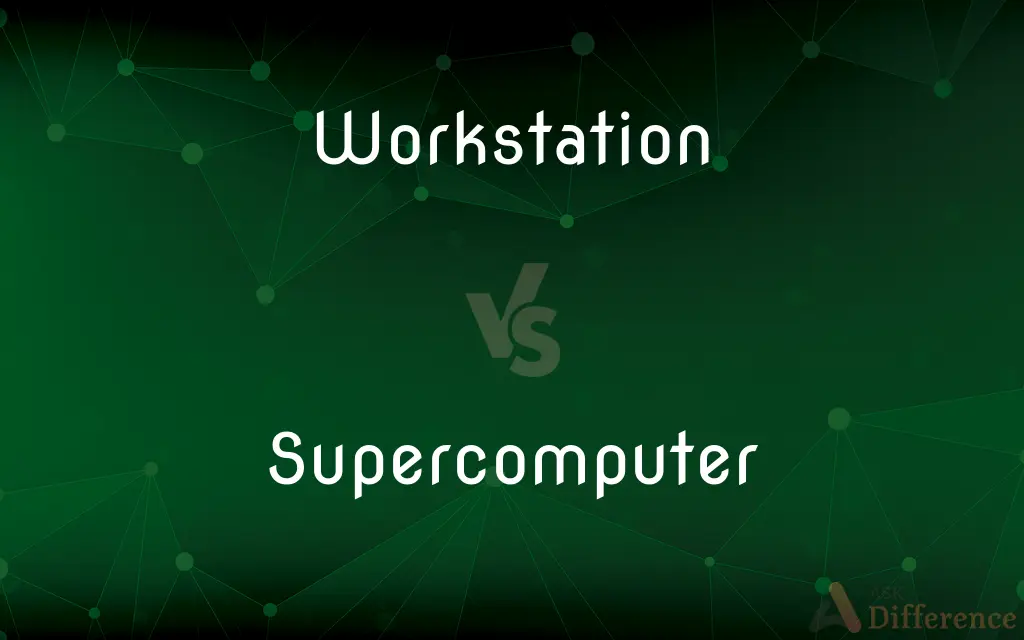Workstation vs. Supercomputer — What's the Difference?
By Fiza Rafique & Urooj Arif — Updated on April 1, 2024
A workstation is a high-performance computer designed for technical or scientific applications, whereas a supercomputer is an extremely powerful computer used for complex scientific calculations.

Difference Between Workstation and Supercomputer
Table of Contents
ADVERTISEMENT
Key Differences
Workstations are powerful computers tailored for individual professionals, offering considerable computational power, reliability, and graphics capabilities for applications like CAD, software development, and digital content creation. On the other hand, supercomputers are at the pinnacle of processing power, designed to perform billions or trillions of calculations per second for tasks such as climate modeling, quantum simulations, and cryptographic analysis.
While workstations are optimized for single-user scenarios with a focus on graphics, processing power, and multitasking capabilities, supercomputers are built for scalability and parallel processing, often used by research institutions and governments for computational tasks beyond the reach of standard computers.
The distinction also lies in their usage and accessibility. Workstations, being single-user systems, are accessible to professionals across various industries, providing a balance between performance and usability. Supercomputers, due to their complexity and cost, are typically reserved for highly specialized tasks that require immense computational resources and are often shared among multiple researchers or projects.
In terms of architecture, workstations may use advanced, commercially available components and emphasize graphical and processing capabilities for a wide range of professional applications. Supercomputers, however, utilize custom architectures that prioritize speed and efficiency for specific computational tasks, often employing thousands of processors working in parallel to achieve extraordinary computing speeds.
Comparison Chart
Primary Use
Technical and scientific applications
Complex scientific calculations
ADVERTISEMENT
Performance
High performance for individual users
Extreme performance for complex calculations
Optimization
Single-user scenarios, multitasking
Scalability, parallel processing
Accessibility
Professionals across various industries
Research institutions, government projects
Architectural Focus
Graphics, processing power
Speed, efficiency, parallel computing
Compare with Definitions
Workstation
A high-performance computer designed for technical and scientific applications.
The architect used a workstation to render complex building models.
Supercomputer
Performs billions or trillions of calculations per second.
The supercomputer was tasked with decrypting complex codes.
Workstation
Available to professionals in various fields.
The workstation’s advanced capabilities were crucial for the data analyst’s work.
Supercomputer
An extremely powerful computer used for large-scale scientific and analytical computations.
Scientists used a supercomputer to simulate global climate changes.
Workstation
Tailored for demanding applications.
His workstation was equipped with a high-end GPU for 3D rendering.
Supercomputer
Used by research institutions for specialized tasks.
Access to the supercomputer was shared among multiple research teams.
Workstation
Optimized for a single professional’s use.
The engineer's workstation allowed for efficient multitasking with multiple monitors.
Supercomputer
Designed for tasks beyond the reach of standard computers.
The new supercomputer will be used for genomic sequencing projects.
Workstation
Used in software development, digital content creation.
The graphic designer optimized her workstation for video editing.
Supercomputer
Utilizes custom components for specific tasks.
Its architecture was designed for efficient parallel processing of data.
Workstation
A workstation is a special computer designed for technical or scientific applications. Intended primarily to be used by one person at a time, they are commonly connected to a local area network and run multi-user operating systems.
Supercomputer
A supercomputer is a computer with a high level of performance as compared to a general-purpose computer. The performance of a supercomputer is commonly measured in floating-point operations per second (FLOPS) instead of million instructions per second (MIPS).
Workstation
A desktop computer terminal, typically networked and more powerful than a personal computer.
Supercomputer
A mainframe computer that is among the largest, fastest, or most powerful of those available at a given time.
Workstation
An area where work of a particular nature is carried out, such as a specific location on an assembly line.
Supercomputer
(computing) Any computer that has a far greater processing power than others of its generation; typically they use more than one core and are housed in large clean rooms with high air flow to permit cooling. Typical uses are weather forecasting, nuclear and other natural science simulations, advanced mathematics and animations.
Workstation
An area, as in an office, outfitted with equipment and furnishings for one worker and usually including a computer.
Supercomputer
A mainframe computer that is one of the most powerful available at a given time
Workstation
A sophisticated computer used for a specific purpose, such as software development or imaging.
Workstation
A desktop computer, normally more powerful than a normal PC and often dedicated to a specific task, such as graphics
Workstation
An area, at a workplace, for a single worker
Workstation
A desktop digital computer that is conventionally considered to be more powerful than a microcomputer
Common Curiosities
Who typically uses supercomputers?
Supercomputers are typically used by research institutions, government agencies, and large organizations for complex computational tasks.
What is the main difference between a workstation and a supercomputer?
The main difference lies in their performance and usage; workstations are high-performance single-user computers, while supercomputers offer extreme processing power for complex scientific calculations.
What kinds of tasks are workstations used for?
Workstations are used for demanding applications such as CAD, 3D rendering, software development, and digital content creation.
How do the costs of workstations and supercomputers compare?
Supercomputers are significantly more expensive than workstations, reflecting their advanced capabilities and the complexity of their tasks.
Are workstations accessible to the general public?
Yes, professionals across various industries can purchase workstations for their high-performance computing needs.
Can supercomputers be used for everyday tasks?
While technically possible, using a supercomputer for everyday tasks would be impractical due to their design for highly specialized computational tasks.
What features make a workstation ideal for professional use?
Features such as high-end processing capabilities, advanced graphics, and the ability to multitask efficiently make workstations ideal for professional use.
What impact do supercomputers have on scientific research?
Supercomputers significantly accelerate scientific research by enabling simulations and calculations that would be impossible or take much longer on standard computers.
Can a workstation be used as a supercomputer?
While a workstation is powerful, it cannot match a supercomputer's capabilities for large-scale computational tasks.
How do supercomputers achieve their processing power?
Supercomputers achieve their processing power through custom architectures that prioritize parallel processing, utilizing thousands of processors to perform calculations simultaneously.
What is parallel processing in supercomputers?
Parallel processing involves dividing complex tasks into smaller ones that are processed simultaneously by multiple processors, significantly speeding up computations.
How do workstations and supercomputers differ in terms of hardware?
Workstations use advanced commercially available hardware optimized for graphics and processing, while supercomputers use custom hardware designed for speed and efficiency in specific tasks.
What advancements are expected in supercomputers?
Future advancements in supercomputers may include even faster processing speeds, greater energy efficiency, and the ability to tackle even more complex scientific questions.
What considerations are important when choosing between a workstation and a supercomputer?
Considerations include the complexity of the tasks, the required computational power, budget constraints, and whether the tasks can be accomplished with single-user capabilities or require parallel processing.
How is data processed differently in workstations and supercomputers?
Workstations process data suited for individual tasks and applications, whereas supercomputers handle massive datasets simultaneously through parallel processing for complex computations.
Share Your Discovery

Previous Comparison
Downgrade vs. Degrade
Next Comparison
Ecumenism vs. EcumenicalismAuthor Spotlight
Written by
Fiza RafiqueFiza Rafique is a skilled content writer at AskDifference.com, where she meticulously refines and enhances written pieces. Drawing from her vast editorial expertise, Fiza ensures clarity, accuracy, and precision in every article. Passionate about language, she continually seeks to elevate the quality of content for readers worldwide.
Co-written by
Urooj ArifUrooj is a skilled content writer at Ask Difference, known for her exceptional ability to simplify complex topics into engaging and informative content. With a passion for research and a flair for clear, concise writing, she consistently delivers articles that resonate with our diverse audience.
















































